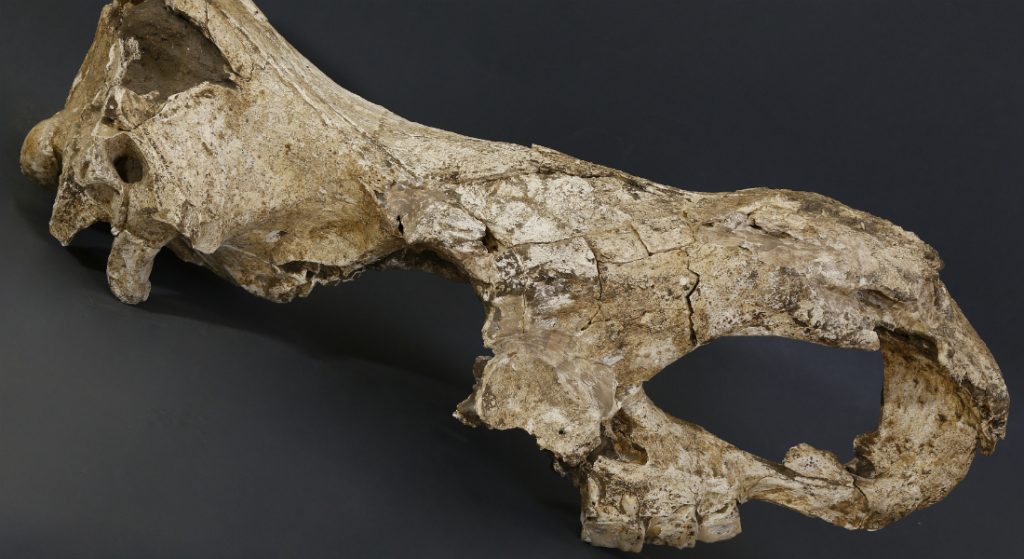New method bursts time frame: Genetic information extracted from a 1.77-million-year-old tooth from ancient rhino
The analysis of a fossil tooth from a 1.77-million-year-old rhino has launched a new molecular method that, for the first time, examines fossil species that go several million years back in time. The method is a groundbreaking step toward a more precise outline of evolutionary history. Behind the study is an international team including researchers from the former DNRF Center for GeoGenetics at the University of Copenhagen; thus, the DNRF funded the research. The study was recently published in the scientific journal Nature.

An international research team led by Danish researchers has succeeded in identifying a complete set of proteins, also called a proteome, that stems from an extinct rhino that lived in Eurasia 1.77 million years ago during the so-called Pleistocene epoch.
It is the largest set of genetic data of such an age that has ever been identified and the genetic information is one million years older than the hitherto oldest DNA sequenced from a 700,000-year-old horse.
“We have been able to find a way to retrieve genetic information that is more informative and reliable than any other source of comparable age before, and it’s from a material that is abundant in the fossil records so the potential of the application of this approach is extensive,” said Enrico Cappellini, associate professor of Palaeoproteomics at the University of Copenhagen.
The result has been achieved by a new method of sequencing the prehistoric proteins using the analysis technology called mass spectrometry. Behind the method and study is a research team which, besides Cappellini, includes researchers from the Center for GeoGenetics (CGG), which was created with a grant from the DNRF and was supported by the foundation for a decade until June of this year.
The research team extracted proteins from the enamel of the rhino’s one tooth, found in Dmanisi, Georgia. By using mass spectrometry for protein sequencing, the researchers could extract genetic information that previously was not possible through regular DNA sequencing.
“For 20 years ancient DNA has been used to resolve questions about the evolution of extinct species, adaptation, and human migration but it has limitations. For the first time we have retrieved ancient genetic information which allows us to reconstruct evolution way beyond the usual time limit of DNA preservation,” said Associate Professor Cappellini.
Dental enamel is the hardest material on the tooth’s surface and the toughest substance in the bodies of both humans and mammals. In analyzing the tooth from the ancient rhino, the researchers found that the set of proteins from the dental enamel lasts longer than DNA and is genetically more informative than collagen, the only other ancient protein so far retrieved in fossils older than one million years.
“With the new, protein-sequencing-based method the possibilities of genetic information have been stretched beyond ancient DNA,” said Jesper Velgaard Olsen, professor and co-corresponding author behind the study. He added:
”This approach can tell us not only the species and the gender of an ancient fossil, but we can also draw an evolutionary line – all from a single tooth.”
“Dental enamel is extremely abundant, and it is highly durable, which is why a high proportion of fossil records are teeth,” Cappellini added.
The beginning of a new chapter
Since the new method makes it possible to collect reliable and excellent genetic information from fossils that are not only thousands but now millions of years old, it marks the beginning of a new chapter in the study of molecular evolution.
”This new analysis of ancient proteins from dental enamel will start an exciting new chapter in the study of molecular evolution,” said Cappellini.
With the method, the researchers hope to use the sequencing of ancient proteins to also study extinct human species whose genetic remains, until now, have presented a challenge because they have been too poorly preserved for the researchers to extract enough DNA.
“There are extinct species of early humans that we haven’t been able to get any DNA from – species like Homo Erectus. The remains we have are too old and too poorly preserved for the DNA to survive. This research is a game-changer that opens up a lot of opportunities for further evolutionary studies in terms of humans as well as mammals. It will revolutionize the methods of investigating evolution based on molecular markers and it will open a completely new field of ancient molecular studies,” said Eske Willerslev, professor and head of center at the former DNRF Center for GeoGenetics.
